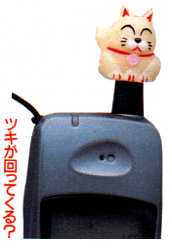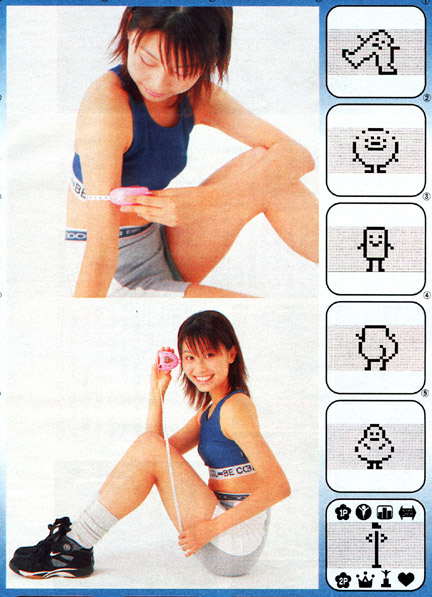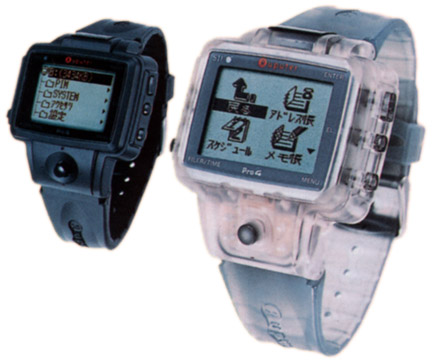Long ago around 1998, I used to publish a website with scans of new or unusual products that appeared in Japanese magazines. Some of them are now obsolete, some have become commonplace. So I thought it would be worth republishing this little time capsule of 1998, exactly as I published it back then. I have several more of these articles, and I’ll post them all.
New Hi-Tech Japanese products
Here are some new products on display in Japanese magazines
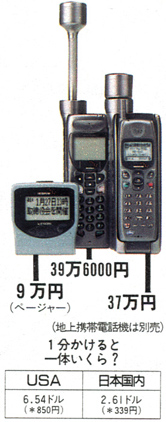
These are the new global satellite phones, and a sattelite text pager. These are made by Kyocera. There is a note describing the cost per minute in Japan and the US. Note that the cost in Japan is $2.61 per minute, compared to $6.54 in the USA (at an exchange rate of 130 Yen per US dollar).
And who could resist a “maneki neko” for their portable phone? It lights up and glows when you talk and transmit!. The maneki neko is a traditional figure, a friendly beckoning cat. I suppose it makes your portable phone a little more “friendly.”
Bodymon: body monitoring devices
Body monitoring toys are a new fad.
This “Slim de Major” is a device about the size of a Tamagotchi, and has a tape measure included. You enter your body measurements, and apparently you also input your exercise activities. It keeps track of this data, and judging from the game icons, it tells you whether you are fat, thin, or have a big butt.
Update: My sister looked at this page. I told her I couldn’t figure out what the top right icon meant. She said it obviously means “Thunder Thighs.”
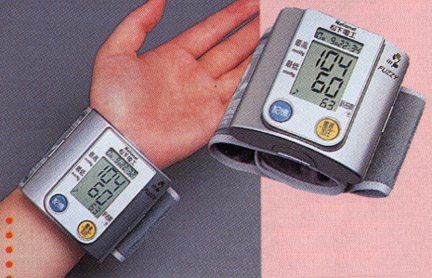
This device measures blood pressure and heart rates. Its can monitor continuously and issue alarms.

I’m not quite sure what device does. It is called the “Tsubo Curator” and it measures and tracks your “tsubo” (whatever that is). The background has pictures of thumbs with various moods and conditions (stress, irritability) written on them. I assume the device measures the skin on your thumb and assesses your condition.
Update: I located “tsubo” in a Japanese dictionary, and it describes tsubo as a point on the body where you would perform moxibustion. These are some type of “energy points” on the body, like acupuncture points. The theory is that your body’s energy flows through these points, and this device must measure it somehow. I’m not too sure how it would do this, maybe galvanic skin response or something simple (it’s a simple little device).
Toys
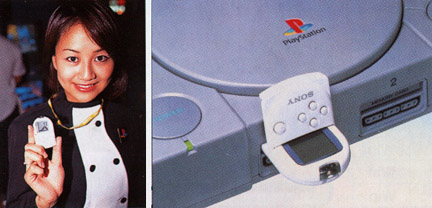
Sony’s Pocketstation is a tamagotchi-sized accessory for your Playstation. You can carry it around and play the game on the little screen, or use it with your Playstation. Can I bring my Crash Bandicoot over to your Playstation for a visit?
Electric scooters. Not exactly high-tech, but it looks like a lot of fun. For Japanese speakers: note use of the popular catchphrase, “dacchuu no” (don’t you know?)
On the left, a silly toy called “Digi-Ken.” It appears to be an old traditional kids toy, there’s a large sphere with a hole, its suspended on a string, and you have to swing the sphere and try to spear it. Except this one is digital. I guess it plays music and lights up if you succeed. I hope it is more interesting to play with than a Yo-Yo.
On the right is the Polaroid Xiao camera, it takes small instant pictures, about the size of those print-club stickers you see everywhere. A nice idea, to make a tiny camera that can make instant prints in this format.
Fancy Wristwatches
The Seiko wristwatch on the left stores about 25 phone numbers or website addresses. I don’t see the point of pushing a bunch of buttons to input a complex URL into my wristwatch, when I could just write it down on a piece of paper. Note that the watch is displaying the URL for Seiko, which is.. www.seiko.co.jp. I never would have guessed, since the display ran out of room after only “http://www.s”
The watch on the right has a special sensor (the grey patch on the front). It can measure sound waves in the air and determine the beats per minute of the song you are hearing. Apparently, this BPM data is vital for people who go to dance clubs.
The “Ruputer” (wrist computer) is a full PDA that interfaces with your desktop computer. You can not input data directly, but you can use it to download data from your desktop PC’s scheduler and address book. The Ruputer will retrieve and display it.
